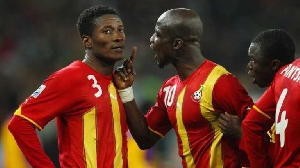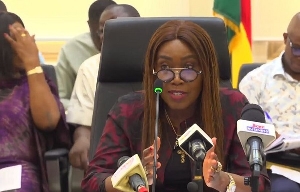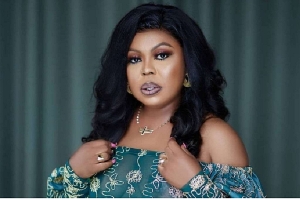- Home - News
- TWI News | TV
- Polls
- Year In Review
- News Archive
- Crime & Punishment
- Politics
- Regional
- Editorial
- Health
- Ghanaians Abroad
- Tabloid
- Africa
- Religion
- Election 2020
- Coronavirus
- News Videos | TV
- Photo Archives
- News Headlines
- Press Release
Opinions of Sunday, 31 July 2016
Columnist: Kwarteng, Francis
Wiyaala is the next big international act to emerge from Ghana - Part 1
“Music is a moral law. It gives soul to the universe, wings to the mind, flight to the imagination, a charm to sadness, gaiety and life to everything. It is the essence of order and lends to all that is good and just and beautiful” (Plato).
“Information is not knowledge. Knowledge is not wisdom. Wisdom is not truth. Truth is not beauty. Beauty is not love. Love is not music. Music is the best” (frank Zappa).
NOELLA WIYAALA
“My next thing is to get into the European market and see what I can do and to show them somebody is coming from Ghana…I’m sure I can easily rub shoulders with all international acts in America doing pure pop music…
“I do have people writing English songs from Europe for me recently because they believe I have the voice and the looks to smash those songs…
“I can do any kind or style of music I want…Reggae, Ragga, Ballad, African, Afro pop, even Pure pop…
“As an African, I still have my African thing and I don’t want to lose that because I just believe from day one that would make me stand out quick and I can never let that go…”
WIYAALA, A GAME CHANGER AND AN INTERNATIONAL ACT IN THE MAKING
This author recently found himself in a captivating topical engagement with one of his many readers from around the world, a Ghanaian lady based in New York who answers to the name Fyederm Nyandiba Laari Sampoah (Debbie for short), a singer in her own right who is also working on her maiden eight-track gospel album, on the subject matter of music and musicians from Northern Ghana, musicians of mostly northern extraction if we may put it that way, a subject matter with which we are glad to profess some intellectual familiarity beyond a passable threshold but also more significantly, to which we have more than deep emotional attachment.
As a matter of fact Ghana truly abounds in musical talent with regard to the North. We may recall the likes of Wiyaala, Sherifa Gunu (Debbie’s friend), King Ayisoba, Atongo Zimba, Onipa Nua, Efya, Rocky Dawuni, Samini, to name but eight, all of whom are, without doubt, extremely talented.
Here, we shall not focus on the historical musicology of the Ghanaian north per se as the subject matter will evidently be beyond the scope of this narrow text. Rather, we shall make sweeping observations and commentaries about the particular music of Wiyaala and her rich eclectic repertoire.
First, from all indications, Wiyaala, already a sensational international act although in a limited sense, is on her way to international stardom. Significantly enough, her mohican or mohawk signature hairstyle has come to eloquently define her cosmopolitan or internationalist appeal.
Then also her projected attention-grabbing image based on a bold concept of gender ambiguity, call it either androgyny or tomboyishness, if you will, coupled with her kinesthetic and terpsichorean flair, lyrical dexterity, and seamless facility for switching among English, Wale, and her native Sisaala, make for a great artiste, an extremely talented, bold and maverick musician whose eclectic repertoire and general musical style defy all pretensions to genre classifications.
Listen to her in her words:
“It’s true that my music is not always genre specific, but I always see it as Afro-centric. I will be releasing an album of my own songs later this year and I will be singing in my local languages of Sissala and Wale as well as English. Some of the songs will sound traditional and local to where I grew up, whilst others will be more mainstream influenced.”
Luckily, the genre non-specificity of her repertoire could also mean that she is more likely to build a large base of assorted fans with an interesting demographic twist, given that the content of her rich eclectic repertoire ranges from purely sybaritic danceable tunes, to introspective tunes, to erudite (deeply political, philosophical and moral) tunes, to folk (traditional) tunes, and to the general.
In other words there is great music in her rich eclectic repertoire for the young, for the old, for those between the young and the old, and for “all” racial, ethnic, cultural and linguistic colors. This bold concept of aesthetic versatility is, of course, the product of a quantum genius.
A gifted singer and songwriter in her own right, Wiyaala has wowed critics and fans alike with smash hits such as “Make Me Dance,” “Rock My Body” (featuring reggae singer Jupiter), “Africa,” “Tuma,” “Tinambaanyi,” “Sun & Moon,” “Leno,” “This is Who I Am” (with Moroccan Ahmed Soultan), and so on.
Her “Rock My Body” recalls Johny Nash’s “Rock Me Baby,” John Mayer’s “Your Body Is A Wonderland,” Inner Circle’s “Sweet (A La La Long),” Bob Marley’s “Rock It Baby”…
Her “Africa” on the other hand recalls Bob Marley’s “Africa Unite” and “Zimbabwe,” the movie “Blood Diamond” which features Beninois actor and model Djimon Hounsou, and Culture’s “Tribal War”…Listen to her on “Africa”:
“The land is good, the land is fine…
“Gold we have, diamonds we mine…
“Yet we fight; we cover it all in blood…
“Tell me why we wallow in the mud…
“Africa! Africa! Africa!...Mama Africa…
“We cry for peace…Africa!...
“Tell me why you fight…Tell me why we fight…
Indeed, the danceable and soothing patterns of her loping and syncopated rhythms that define some of her songs are a pure joy to the ear, to listen to outside the usual incongruous (un-symphonic) and earsplitting noises one usually hears all over the place in the contemporary world of hip-life rap.
Content-wise, though, the subtextual nuances and subtleties of “Make Me Dance,” for instance, may represent a sister- or sibling-song to Beyonce’s “Flawless” and Chimamanda Ngozi Adichie’s “We Should Be Feminists.”
It is, therefore, no wonder that some feminist-oriented magazine(s) should give it, “Make Me Dance,” some respectable coverage in their pages.
Such is, indeed, deserving of a truly young hardworking woman who is capitalizing on her newly acquired fame (and celebrity status) for public good insofar as the rights of women and the girl child.
Wiyaala snatches every opportunity that comes her way and uses that, to represent the voice of women and of the girl child.
What is even more interesting about her, perhaps, is her rich, powerful trademark ivory or silky voice…a velvety…an almost angelic…voice that has come to define her music, which, among other unique characteristics, is not evidently “forced” or “strained” as in, say, Becca’s. Let us add with some authority lest we are misunderstood, that Becca nonetheless has a uniquely powerful and rich voice that stands tall among the high caliber voices of mainstream Ghanaian divas.
That characteristic tone quality, of Wiyaala’s, has a glowing touch of aesthetic versatility which, although it may not measure up to the 5-octave vocal range of a Maria Carey, say, who could also hit a 7-octave vocal range, or to the powerful voices of Kelly Clarkson, Aretha Franklin, Christina Aguilera, Martina McBride, Concha Buika, Whitney Houston, Adele, Florence Welch, and Patti Labelle, Wiyaala’s arguably has what it takes, namely the aesthetic architectonics of internal richness, of the kind of projective power that can be further groomed, polished or nurtured to make a serious, bold vocal presence or statement in the creative world of music.
But even more so, her music is undeniably what we shall call “art” in the truest sense of the word, perhaps “art” in the sense of the musical aesthetics of Koo Nimo’s, Obrafour’s, M.anifest’s, Joe Mensah’s (of “Bosoe” fame), Kwadee’s, Ephraim Amu’s, Kojo Aquai’s, Wulomo’s, Jerry Hansen’s (of The Ramblers Dance Band), Kwabena Nketia’s, E.T. Mensah’s, to name but a few, notable repertoires.
And yes Jamaica’s Grace Jones lookalike, Wiyaala writes all her songs too.
In addition to, it is also not easy to overlook the Afro-centric overtones in some of her rich music sheets, choreography, music videos and music video costumes.
It is, however, interesting to note that she also designs her own clothing line and jewelry to showcase the artistic and aesthetic creativity of her people.
Wiyaala’s Afro-centric image brings back memories of Asabea Cropper whom one writer Eyra Doe fondly about:
“Known for her unique Kente culture, her traditional ‘Tekuwaa’ (headgear) her horns, beads, kente outfit and that silky voice with the Ada lyrics, she dazzled Ghanaians, together with her brother Kenteman, to woo the hearts of many Ghanaians in the ‘90s…
“When I see the Raquel’s, the Efya’s, the Irene’s and the Samini’s doing well, I feel so happy…
“Asabea Cropper, who is a proud Ga Adangbe, never hesitates to showcase her culture. She explains what motivates her to dress the way she does.
“‘In the 1960’s we were taught in school about African Personality in the days of Kwame Nkrumah, so that is where we I got this from. Also, my grandmother, who used to put these beads on us and my mum who used to wear the Kente, bought me my first Kente. I wanted to be unique so that was why I combined all these ‘the ‘tekuwa’s, the Ahenema’s and my Kente.’”
The music video for Wiyaala’s “Africa” is a typical teachable example of what it means to be Afro-centric.
OTHER POINTS WORTH NOTING
Wiyaala is already Angelique Kidjo and Miriam Makeba and Alpha Blondy and Concha Buika and Lucky Dube and Fela Kuti and Osibisa and Youssouf N’Dour and Yvonne Chaka Chaka and Evi Edna Ogholi…in the making, a feat that will no doubt require some serious or hard work from aptitudes ranging from songwriting, dance chemistry, vocalization, self-marketing and career development, branding to video choreography, among others.
Yet an expert voice coach or masterclass instructor can bring out other nuances and subtleties locked up in her timbre, to enhance her vocal range not necessarily in the octave vocal range of those we mentioned previously.
Significantly, she may also not want to rely too much on mechanization and the synthesizer to mask her vocal deficits, although the latter can also equally enrich the rhythmic instrumentation of her music.
Yet our critical reservations about the heavy mechanization of music notwithstanding, there are those out there who are not aware that the synthesizer enriched the roots reggae of Bob Marley & The Wailers and Steele Pulse, just to mention but two.
For instance, record executives “forced” Steele Pulse to go commercial by moving away from the roots reggae genre since, according to those same record executives, patrons and the general listenership of the genre were moving away from it toward more mainstream sub-genres of reggae, a move that gave Steele Pulse no choice other than to adopt the synthesizer.
The band relied on synthesizer to compose its music sheets.
EXPANDING THE INSTRUMENTATION BASELINE OF SOME OF OUR MUSIC FORMS
Others have also used certain musical instruments to mask their vocal deficits. The violin, the trombone, the bassoon, the tuba, the piccolo, the viola, the oboe, the clarinet, and the cello, to mention but a few, are hardly popular in contemporary music genres such as hip-life (and its variants). That is to say, generally, mastered deployment of a wide range of musical instruments in our contemporary music forms can overshadow or take over from where serious vocal deficits evidently exist. This is exactly what Alpha Blondy, the Ivorian international roots reggae superstar, brings to his signature reggae, the pleasant aromas of cello and violin instrumentation.
Then also, Paul Simon, the world-famous American folk-rock musician from New Jersey—the home state of popular rock guitarist, songwriter and lead singer of Bon Jovi, the latter of which is also incidentally the name of the lead singer—incorporated South African drum rhythms, kwele pennywhistle, isicathamiya and mbaqanga vocal elements and instruments into some of his well-known masterpieces, collected together as his seventh solo album “Graceland” (after his painful breakup from band partner Art Garfunkel).
“Graceland” is an eclectic studio album that would eventually go on to win a Grammy for Album of the Year (1987).
Thus Paul Simon, in effect, took advantage of native South African musical instruments, exquisite yet complicated vocal stylization techniques to enrich an important department of his eclectic repertoire, “Graceland,” where the American musical landscape could not have offered him and the album such.
Ironically, we hardly even hear the kind of guitar riffs normally associated with the likes of Ali Farka Toure, Eric Clapton, B.B. King, John Mayor, Prince, Wyclef Jean, Vernon Reid, George Harrison, Neal Schon, Joe Perry, Prince Nico Mbargo, Jimi Hendrix, Keith Richards, Jeff Beck, Buddy Guy, Carlos Santana, Robbie Shakespeare, Aston Barrett, Robert Randolph, Neil Young…in the contemporary landscape of Ghanaian music including hip-life and highlife!
Neither do we feel any strong sense of the kind of rich syncopated and sinusoidal drum beats we got from the likes of Peter Tosh’s Sly Dunbar, Bob Marley’s Carlton Barrett (noted for his “one drop rhythm”), and Fela Kuti’s Tony Allen and his [Fela’s] contemporary Adebayo Santos Martins’ (or Bayo Martins for short, a drummer who worked with one of our loyal readers, a writer, poet and ex-professor of literature at one of California’s universities/colleges, in Europe. Our friend appeared on platforms together with the likes of Wole Soyinka and world-famous Somali dissident writer, Nurrudin Farah, for poetry/book readings) nor the rich ivory sound-signature derived from the tactile-generated sonics of Elton John, Thelonius Monk, Little Richard, and Billy Joel.
Nor the technical sophistication feeding the screaming and whining polyphony of Yo-Yo Ma’s cello…
This is partly because the heavy mechanization of music (the heavy use of synthesizer, for instance) has completely taken over the sort of “naturalness” we expect from the organic melody, rhythm and harmony that great talents and virtuosos manage to squeeze out of musical instruments. This is why we should also ask our artistes to produce live albums from time to time in addition to studio albums.
One of the true tests of a singer is if and when he or she can naturally sing or perform as good with live instruments (band) as with synthesizer-induced accompaniment (or instrumentation). Thus, Wiyaala may want consider learning one or two musical instruments as Alicia Keys, Lauryn Hill, India Irie, Miri Ben-Ari, Terry L. Carrington, etc., if she has not already done so (Note: See Ellen Koskoff’s paper “When Women Play: The Relationship Between Musical Instruments and Gender Style,” Canadian University Music Review (1995), Vol. 16, No. 1, p. 114-127).
Of course, we take into consideration the expenditure an artiste is likely to incur in the special case of hiring or contracting session musicians. This fact does overlook the fact that a number of our popular contemporary artistes are technically professional Milli Vanillis, since they are not so good at live performances with session musicians, say. Wiyaala is an exception rather than the rule here.
This brings to the fore the controversial idea that even Kojo Aquai, late, a man who had an advanced degree in music/music theory, who taught music in America for some time before returning to his native Ghana, and who composed great, high caliber music did not consider himself a “musician” on the basis of the fact that he did not play any musical instrument. This is a significant observation.
Yet a number of our hip-life rappers see themselves as “musicians” when, in actual fact, they are technically merely “singers.” A great hip-life artiste like Obrafour raps and sings so well, feats highly demonstrative of his musical, lyrical and artistic dexterity. Akwaboah, Jr. is another one who comes across as a sophisticated singer, songwriter, producer, and keyboardist. Akwaboah is a typical “musician.”
FOOD FOR THOUGHT
It pays for a singer to be lyrically multilingual as Wiyaala already is. Enya, the reclusive Irish singer-songwriter and musician sings in ten languages; Alpha Blondy is lyrically multilingual as well…the list is endless. Yet sometimes, too, a singer can also be coached or taught to do a rendition or cover version of a song in its original language format, a language that the singer may not be familiar with, or even a new track in a language the singer or musician, once again, does not speak.
But such a musician or singer must have some natural facility for languages. This was how Miriam Makeba took an East African (Tanzanian) love song in Swahili, “Malaika,” and turned it into a global sensation.
We give all these famous instances to guide Wiyaala as she develops musically and artistically.
MECHANIZING MUSIC
What is more, like the human voice, musical instruments have their own limitations hence the need for mechanizing music via such technological innovations as the synthesizer and electronic media. Many a time the synthesizer makes instrumentation and music sheet easier to translate.
It all depends on how simplistic or complex a singer or a musician or a composer or a producer wants his or her music and also on how he or she thinks the consumer will interpret it. And yet again compositional, harmonic, rhythmic and melodic simplicity (“thin texture”) does not necessarily assign a musical piece to a back burner of aesthetic irrelevance, of aesthetic inferiority.
For instance, the Third Degree’s classic “When Will I See Again,” written by Leon Huff and Kenny Gamble, one of the memorable smash hits of the Philly Era dispensation was rejected by many a singer who was offered the song, the reason for its rejection primarily being its seeming compositional simplicity.
Here is what Sheila Ferguson, the lead singer of The Third Degrees, had to say regarding the song:
“The song was played to me by Kenny Gamble at the piano in 1973 and I threw a tantrum. I thought it was ridiculously insulting to be given such a simple song and that it took no talent to sing it. We did do it and several million copies later, I realized that he knew more than me.”
A great lesson for Wiyaala!
Yet, taking into consideration the concept of incorporating concepts of compositional complexity (“thick texture”) into formulations of music sheets, through the addition of intermingling layers of instruments ranging from the violin and to the cello, to an otherwise simple piece of song or composition, can and do enrich the contents of music sheets and add to improved performance.
Such a level of compositional complexity is what Irish musician and songwriter, Enya’s extensive repertoire, is made of, a repertoire that requires orchestras and choirs to interpret as part of live performances.
In fact such an approach to creating music sheets of some compositional complexity, and their patronage, will largely depend on the level of technical sophistication of consumers’ musical tastes as well as on how the singer or musician effectively interprets this compositional complexity to a level the average listener of music understands.
Wiyaala should take note of all these.
On the other hand it is not advisable even for her, Wiyaala, either to put unnecessary pressure on or to push her “inelastic” vocal range, timbre, or tone quality beyond the natural threshold.
Such a move could be counterproductive as was rumored to have been the tabloid case of Whitney Houston, after her executing her successful rendition (or cover version) of Dolly Parton’s “I’ll Always Love You” (with Kirk Whalum on sax; the song also appeared on the soundrack for “The Bodyguard”).
Of course, and perhaps more particularly so, drug use (and aging) could also have been a major factor in Whitney’s voice attenuation, a view generally associated with her album “I Look To You,” a beautifully powerful title song R. Kelly wrote as his colorful contribution to her seventh studio album compilation, and yet, here, we hope that Wiyaala, “the doer” and “the young lioness of Africa,” will take a cue from Whitney’s experience and avoid drugs altogether.
Admitted, certain drugs do allegedly play some important influential and inspirational roles in the careers of artistes. Marijuana is a famous one on almost every known pharmacopoeia of inspirational artistic expression but perhaps more than that also, many musicians from around the world tend to use drugs for a variety of reasons including, but not limited to, the management of stage fright, onstage jitters or performance anxiety and physical pain during live performances.
Once again Wiyaala should avoid drugs!
CONCLUDING REMARKS
We will like to suggest to Wiyaala and her management team not to rest on their laurels but to push the boundary for their rising star.
Perhaps, one way to do this is for her to try her hand at more international collaborations (like the one she did with popular Moroccan singer, Ahmed Soultan), at modeling (she has the natural beauty of Sudanese-born international model Alek Wek), at acting (she also has the natural beauty, natural flair and flash of Mexican-Kenya filmmaker and actress, Lupita Nyong'o), and at singing (here, too, she has the natural beauty of Jamaica’s Grace Jones, who has done well for herself and her country in both acting and singing).
This is if and only if she has the talent, the willingness, and the psychological, emotional wherewithal to take up these new challenges!
She may also try her hand at renditions or cover versions of songs, such as the popular example we gave involving Whitney Houston’s classic rendition of Dolly Parton’s “I Will Always Love You.”
Then she can also consider a quasi-biographical or –autobiographical documentary film, such as the late Prince’s “Purple Rain” or Whitney Houston’s “The Bodyguard,” although the latter is not to be construed in that technical sense of a quasi-biographical or –autobiographical documentary film. Yet this suggestion still falls under the larger rubric of acting, anyway.
And, she may consider writing an autobiography or consider approving an authorized biography, a means to share her unique story with the rest of the world. The point here is to expand her local and international fan base alike. This requires that we also patronize her work as well as spread the word.
We shall return with Part 2, the concluding installment.
REFERENCES
Akatasia. “Questions With Afro Pop Artist Noella Wiyaala.”July 17, 2013. Retrieved from http://akatasia.com/music-2/questions-with-afro-pop-artist-wiyaala/
Ghanagist.com. “Wiyaala And Bro Philemon Win Gold For Ghana At All Africa Music Awards.” December 27, 2014. Retrieved from http://ghanagist.com/wiyaala-and-bro-philemon-win-gold-for-ghana-at-all-africa-music-awards/
Jeff Nicolson. (2012, December 17). “Tracing the Roots of Paul Simon’s Graceland.” Retrieved from http://africanmusicbostoncollege.blogspot.com/2012/12/tracing-roots-of-paul-simons-graceland.html
Eyra Doe. (2015, March 27). “Veteran Asabea Cropper To Release A Song This Year.” Retrieved from http://www.myjoyonline.com/entertainment/2015/march-27th/veteran-asabea-cropper-to-release-a-song-this-year.php
Kristen Warnick. (2000, April 1). “Influences on Contemporary Ghanaian Dance: An Exploration of Viewpoint.” Retrieved from http://digitalcollections.sit.edu/cgi/viewcontent.cgi?article=1071&context=african_diaspora_isp
Ghanaweb. “Ghanaian Afro-pop Star Wiyaala Eyes European Market.” March 5, 2015.










